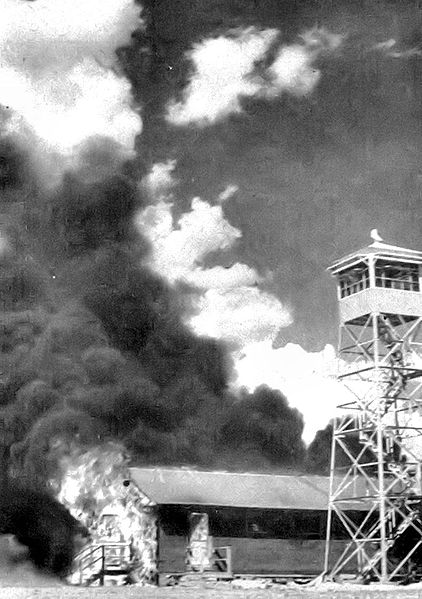The Bat Bomb

Unless, that is, you count the lives of the millions or so bats which would have died in the process.
In the mid-1940s, many Japanese buildings were still constructed out of wood and paper, which, of course, were flammable. If the U.S. could figure out a way to start fires in a large number of buildings spread out over a wide area, the Japanese infrastructure and economy would suffer but the direct loss of life would be relatively smaller. But that seemed impossible. Napalm strikes could start fires everywhere in its path, but that wouldn’t spread. And carpet bombing with many small warheads would increase the area of the strike, but most likely wouldn’t cause many fires. And of course, the death toll from either of those routes could still be rather large.
But a few months before the Manhattan Project got underway, a dental surgeon named Lytle Adams came up with the idea to use bats — the nocturnal flying mammals — as part of the strategy. As he would later tell Air Force Magazine, after seeing millions of bats flying around caves in Carlsbad Cavern, New Mexico, he immediately thought that they could be used as a way to spread firebombs throughout Japan. He collected a few of them himself, did a little research, and found that even tiny bats weighing well under a pound could carry three times their weight in explosives. He pitched his plan to the military (which apparently was not uncommon at the time) and the military agreed that there was something more to look into.
Adams’ theory was straightforward. Collect a million of bats and strap timed incendiary devices to their backs while they hibernated. Stick a thousand of them each into a thousand bombs designed to open at high altitudes. Fly over Japan at night, drop the bombs, and then let the bats fly around. When daybreak comes, the theory went, the bats will hide in dark places — and given where they are, the most common hiding place will be attics. The timer ticks down shortly after and, without obvious explanations, hundreds of thousands of Japanese buildings start to burn to the ground.
The idea was not just a theory, either. By March of 1943, the U.S. military had identified a suitable population of bats, having located a series of caves in Texas which was the home to millions of the flying critters. For the next year or so, at the expense of $2 million ($25 million in today’s dollars), they tested Adams’ theory. Except for one major problem — at one point, some bats got loose resulting in a major fire at the base, as seen above — the military believed that the bat bombs could actually work. One report placed their effectiveness at ten to thirty times more effective (measured by the number of fires which would have started) than conventional incendiary devices.
But the final report on the bat bombs issues in mid-1944, while positive, noted that they would not be ready for combat for another year. Due to the slow time table, the military canceled the project before it could be fully developed.
Bonus fact: Bats eat insects (among other things), including malaria-carrying mosquitoes. In the 1920s, a researcher named Charles Campbell proposed building “bat towers” which would provide a roost for bats during the day so they could feast on the mosquitoes at night. There’s an active one at the University of Florida, as seen here, but the most famous one is probably the Sugarloaf Key Bat Tower in the Florida Keys. The Sugarloaf tower was built in 1928 by a fish lodge owner named Richard Perky with much fanfare — and with one big problem. According to Atlas Obscura, when Perky put the bats into the tower, they flew off to find some bugs to eat — and never came back.
From the Archives: Fangs for the Blood: Vampire bats share with each other.
Related: A miniature Batman bat signal.

Leave a comment